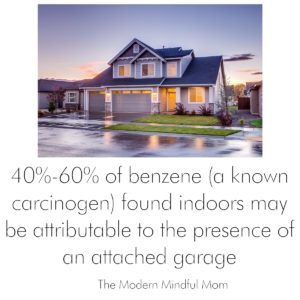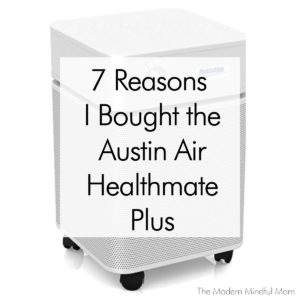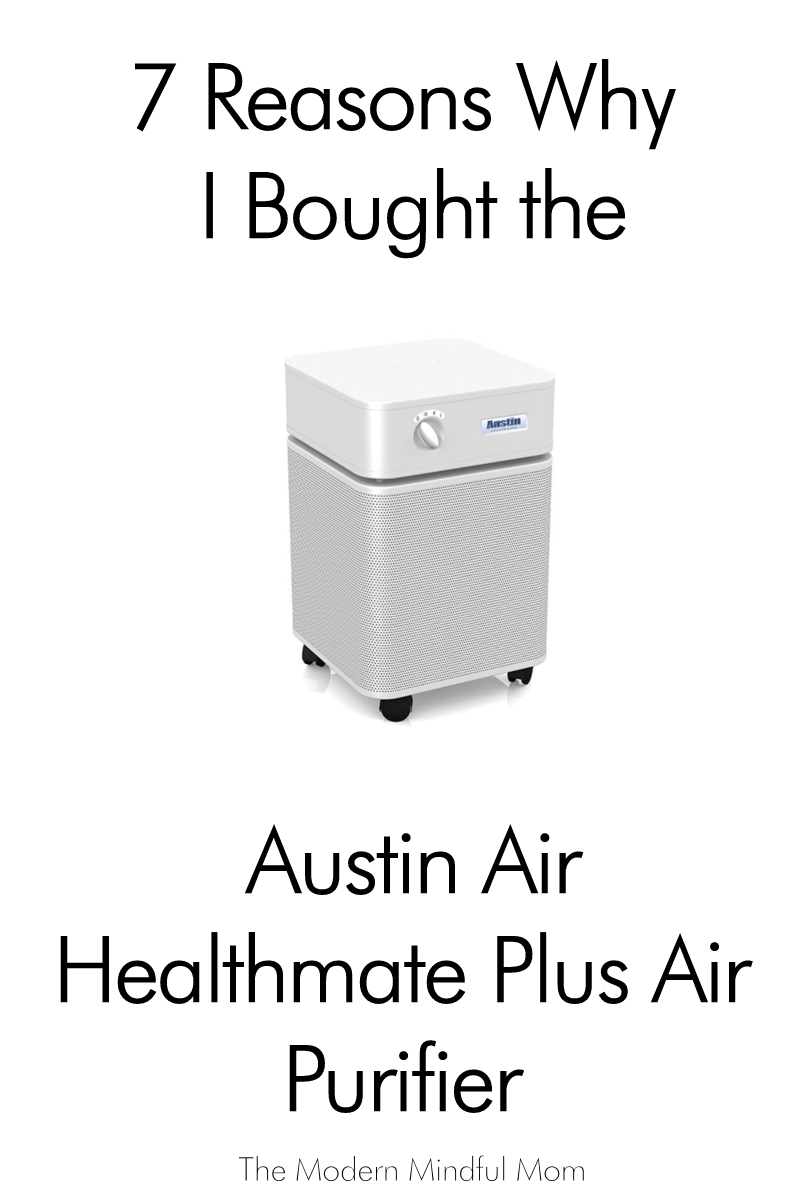A Brief Background
On my “Quest for Better Indoor Air Quality,” I decided to to purchase an air purifier. After doing hours and hours of research, I landed on the Healthmate Plus, made by Austin Air. Below are the reasons why. Some reasons were weighted more heavily in making my decision, but it was ultimately the culmination of all these factors.
1. Filters VOCs (Volatile Organic Compounds)
There are tons of air purifiers on the market. Most are HEPA air purifiers, which filter out larger (0.3 and above) micron-sized particulates from the air.
However, one thing I am concerned about is VOCs, or volatile organic compounds. HEPA air purifiers do not filter out VOCs. There are air filters that do filter out VOCs, but there are significantly less of them on the market.
Having an air purifier that filtered VOCs was a must-have requirement on my list.
VOCs include a variety of chemicals found in the air, many of which are toxic and have known health dangers. Children are especially susceptible to the dangers of VOCs.
Studies have found that VOC levels average 2 to 5 times higher indoors than outdoors. VOCs are unfortunately caused by our many day-to-day activities, like cooking and cleaning. Additionally, VOCs often off-gas from common items found in homes, like furniture and building materials.
The Austin Air Healthmate Plus is an air purifier that specifically targets VOCs. There is a slightly cheaper version (the Healthmate) that also filters VOCs, but the filter in the Healthmate Plus includes potassium iodide, which makes it more effective at removing formaldehyde, benzene and a broader range of other VOCs.
Both formaldehyde and benzene are known carcinogens.
According to the World Health Organization:
Common sources of formaldehyde include:
- Furniture and wooden products containing formaldehyde-based resins such as particleboard, plywood and medium-density fiberboard
- Insulating materials
- Textiles
- Building materials such as paints, wallpapers, glues, adhesives, varnishes and lacquers
- Household cleaning products such as detergents, disinfectants, softeners, carpet cleaners and shoe products
- Cosmetics such as liquid soaps, shampoos, and nail polish
- Electronic equipment, including computers
- Other consumer items such as insecticides and paper products
Common sources of benzene include:
- Outdoor air
- Building materials
- vinyl, PVC and rubber floorings,
- nylon carpets and SBR-latex-backed carpets,
- paint and paint remover,
- wood panelling,
- caulking
- Furniture, especially those made of particleboard or plywood
- Attached garages
- 40–60% of benzene indoors may be attributable to the presence of an attached garage
- Benzene can be emitted from cars (including gas and oil), and other items commonly stored in the garage (paint, lacquer, solvents, hobby supplies, etc.)
- Cooking
- Cleaning

I decided to go with the Austin Air Healthmate Plus since it filters out such a broad range of VOCs and more effectively filters out the scary (unavoidable) ones like formaldehyde and benzene.
I am especially concerned about VOCs for a few reasons:
- I have a young child. Children are more susceptible to the dangers of VOCs.
- I have an attached garage. As mentioned above, attached garages contribute can significantly increase the amount of benzene (a known carcinogen) in the home.
- I am replacing the windows in our home soon. Building materials and remodel projects are known to not only create dust, but also cause an increase in VOC emissions.
2. Room Coverage
The Austin Air Healthmate Plus purifier is recommended by the manufacturer for room sizes up to 1,500 square feet.
The Austin Air Healthmate Plus will filter the air one time in a 1,500 square foot room.
However, for allergy sufferers, it may be beneficial to use the Healthmate Plus in a smaller room so the air is filtered more frequently. Below shows the number of air changes the Healthmate Plus can achieve based on the size of the room:
- 875 sq. ft. (2 air changes per hour)
- 600 sq. ft. (3 air changes per hour)
- 465 sq. ft. (4 air changes per hour)
- 375 sq. ft. (5 air changes per hour)
- 315 sq. ft. (6 air changes per hour)
3. Testimonials
I personally know several people who have this air purifier (and have had it for years). I also read through dozens and dozens of reviews on-line. Over the years, it has gotten overwhelmingly positive reviews.
Another positive testament to the performance of this air purifier is the fact that they are used by the U.S. Corps of Engineers, FEMA and the Red Cross to address various air quality concerns.
I relied on the positive testimonials when deciding to get this air purifier. But another thing I took away from the testimonials were the criticisms…all the negative comments people had, problems they’ve experienced or nuances related to this purifier.
I ultimately decided that the downsides or “issues” that I could encounter were worth taking on.
For instance, one downside often reported is that this air purifier is on the noisy side, especially on the higher settings. For me, this isn’t a deal breaker. It’s especially not worth the sacrifice in performance, or worth paying more for a quieter machine.
Another nuance of this air purifier, is that compared to some of the competition, accessing the filter is a little more involved. You have to flip the purifier over and then use a screwdriver. And this thing weighs 47 pounds! Again, this is not a dealbreaker for me, but for this reason alone, this may not be the best purifier for someone else.
4. Third Party Testing
There is no standard testing for VOC filtration. However, Austin Air claims that the filtration effectiveness has been independently tested by a third-party and United States Government laboratories.
5. Cost
The cost of the Healthmate Plus is $715. The replacement filter costs $360.
Compared to the competition, I find this price to be very reasonable considering the performance and room coverage.
Additionally, I was able to get a substantial discount, which helped make this the clear winner in my book.
You too can take advantage of this discount. Reach out to Hannah with Green Slate Consulting. She has a doctorate in epidemiology from Harvard. She is on a mission to help families make small easy changes to reduce their exposure to toxic chemicals and identify the healthiest and safest nontoxic products for their home. As part of this work, she is an authorized dealer for Austin Air purifiers.
Not only was her pricing the cheapest I could find, I also am a huge fan of her work and wanted to support her business.
6. One Filter
When researching air filters, one factor that drew me to this brand is the fact it has one air filter. Simple to maintain and change.
I was drawn away from other brands of air purifiers due to the fact that they contain multiple filters. Each of the different filters have their own protocols for maintaining and changing.
The fact that this air purifier requires less maintenance is very appealing to me. I already have so many things to juggle and remember!
7. Predictable Future Costs
The fact that there is only one air filter makes it much easier to predict the future cost of maintaining the air purifier. With any air purifier filter, there is a variation in life expectancy based on the quality of the air (among other things).
The estimated life expectancy for the Healthmate Plus air filter is 5 years, but many report needing to replace it as soon as every 2-3 years. This gives some idea of what you can expect to pay to maintain the air purifier.
When trying to compare this against future costs for air purifiers containing multiple filters, it became much more difficult. With each filter having their own range of life expectancy and their own price tag, it’s hard to accurately predict future costs. There are too many moving parts.

That sums up the 7 reasons I bought the Austin Air Healthmate Plus! Hope this was helpful if you’re facing a similar decision!
Neither Austin Air or Green Slate Consulting sponsored this post in any way! Just wanted to share what worked for me in an effort to help others!


